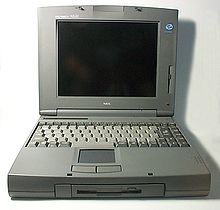PC-98: Difference between revisions
If you're not gonna create an article for the actual PC-98, then the opening sentence has to be modified to remove the "part of the PC-98" part. |
PC-98 |
||
| (2 intermediate revisions by the same user not shown) | |||
| Line 1: | Line 1: | ||
{{refimprove|date=February 2009}} |
{{refimprove|date=February 2009}} |
||
{{expert|date=October 2011}} |
{{expert|date=October 2011}} |
||
[[File:PC9821 Nb10 NEC.jpg|thumb| |
[[File:PC9821 Nb10 NEC.jpg|thumb|NEC PC-9821 NB10 [[laptop]]]] |
||
{{For|the 1998 computer guideline by Microsoft and Intel|PC System Design Guide}} |
{{For|the 1998 computer guideline by Microsoft and Intel|PC System Design Guide}} |
||
The '''NEC PC-9801''' is a [[Japan]]ese [[16-bit]] [[microcomputer]] manufactured by [[NEC Corporation|NEC]]. The platform established NEC's dominance in the Japanese [[personal computer]] market, and by 1999, more than 18 million PC-98 units had been sold.<ref>{{cite journal|title=Computing Japan|journal=Computing Japan|year=1999|volume=54-59|url=http://books.google.co.uk/books?id=oP61AAAAIAAJ|accessdate=6 February 2012|page=18|publisher=LINC Japan|quote=...its venerable PC 9800 series, which has sold more than 18 million units over the years, and is the reason why NEC has been the number one PC vendor in Japan for as long as anyone can remember.}}</ref> |
The '''NEC PC-9801''', or '''PC-98''' series, is a [[Japan]]ese [[16-bit]] [[microcomputer]] manufactured by [[NEC Corporation|NEC]] from 1982 onwards. The platform established NEC's dominance in the Japanese [[personal computer]] market, and by 1999, more than 18 million PC-98 units had been sold.<ref>{{cite journal|title=Computing Japan|journal=Computing Japan|year=1999|volume=54-59|url=http://books.google.co.uk/books?id=oP61AAAAIAAJ|accessdate=6 February 2012|page=18|publisher=LINC Japan|quote=...its venerable PC 9800 series, which has sold more than 18 million units over the years, and is the reason why NEC has been the number one PC vendor in Japan for as long as anyone can remember.}}</ref> |
||
== History == |
== History == |
||
Revision as of 15:27, 13 May 2012
This article needs additional citations for verification. (February 2009) |
This article needs attention from an expert on the subject. Please add a reason or a talk parameter to this template to explain the issue with the article. (October 2011) |

The NEC PC-9801, or PC-98 series, is a Japanese 16-bit microcomputer manufactured by NEC from 1982 onwards. The platform established NEC's dominance in the Japanese personal computer market, and by 1999, more than 18 million PC-98 units had been sold.[1]
History
It first appeared in 1982,[2] and employed an 8086 CPU. It ran at a clock speed of 5 MHz, with two µPD7220 display controllers (one for text, the other for video graphics), and shipped with 128 KB of RAM, expandable to 640 KB. Its 8-color display had a maximum resolution of 640×400 pixels. Its successor, the PC-9801E, which appeared in 1983, employed an 8086-2 CPU, which could selectively run at a speed of either 5 or 8 MHz. The NEC PC-9801VM used NEC V30 CPU.
When the PC-98 was launched in 1982, it was initially priced at 298,000 yen (about 1,200 USD in 1982 dollars).
In the 1980s and early 1990s, NEC dominated the Japan domestic PC market with more than 60% of the PCs sold as PC-9801 or PC8801. In 1990, IBM Japan introduced the DOS/V operating system which enabled displaying Japanese text on standard IBM PC/AT VGA adapters. After that, the decline of the PC-98 began. The PC-9801's last successor was the Celeron-based PC-9821Ra43 (with a clockspeed of 433 MHz), which appeared in 2000.
While NEC did not market these specific machines in the West, it did sell the NEC APC III, which has similar hardware as early PC-98 models.[3]
Hardware
The PC-98 is different from the IBM PC in many ways; for instance, it uses its own 16 bit C-Bus instead of the ISA bus; BIOS, I/O port addressing, memory management, and graphics output are also different. However, localized MS-DOS or Windows will still run on PC-9801s.
Clones
Seiko Epson manufactured PC-9801 clones, as well as compatible peripherals.
Software
Software for the PC-98 generally ran from program and data disks (Disk 0 & 1) or (A & B), and NEC did not have a strong GUI to go up against Microsoft's Windows 95 when it took Japan's PC market by storm. NEC's decision to work with Microsoft to offer a PC-98 compatible version of Windows 95 could be seen as the first step towards the PC-98's downfall, as consumers were no longer required to have an NEC-built system to run software designed for Windows.
The PC9801 had thousands of game titles designed for it, many of which made creative use of the system's limitations (it was originally designed as a business machine) to great commercial success. Despite having hardware specifications far inferior to the Fujitsu FM Towns and Sharp X68000 personal computers, the massive install base and steady flow of game titles (in particular "dōjin" style dating sims and RPGs, as well as early games of the Touhou Project franchise) kept it as the favored platform for PC game developers in Japan until the rise of the DOS/V clones.
NEC kept much of its hardware and platform proprietary or under license, so while it had a virtual monopoly in the Japanese market, later IBM PC clones with DOS/V and Windows from companies such as Hitachi and Panasonic that did not require such license fees (like Epson's 98 clones) flooded the market and displaced NEC. The proprietary technology that was NEC's strength turned into its weakness as its competitors could use off-the-shelf technology to build cheaper IBM PC clones at a time when NEC was charging much steeper prices for its PC-98s.
See also
References
- ^ "Computing Japan". Computing Japan. 54–59. LINC Japan: 18. 1999. Retrieved 6 February 2012.
...its venerable PC 9800 series, which has sold more than 18 million units over the years, and is the reason why NEC has been the number one PC vendor in Japan for as long as anyone can remember.
- ^ John Szczepaniak. "Retro Japanese Computers: Gaming's Final Frontier". Hardcore Gaming 101. p. 2. Retrieved 2011-03-16. Reprinted from "Retro Japanese Computers: Gaming's Final Frontier", Retro Gamer, no. 67, 2009.
- ^ "Old-Computers.com". Retrieved 5 May 2011.
